All 12 entries tagged Augustus
No other Warwick Blogs use the tag Augustus on entries | View entries tagged Augustus at Technorati | There are no images tagged Augustus on this blog
August 01, 2015
Ain't talkin' 'bout love. Roman "Spintriae" in context.
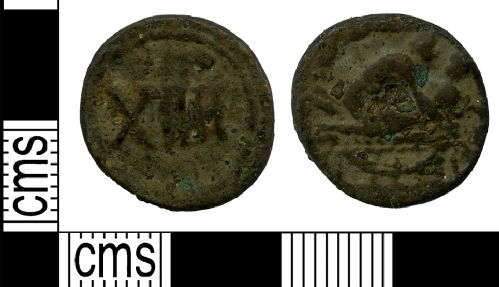 |
| Roman token, found in the Thames, PAS LON-E98F21 |
In 2012 this token was found in the Thames in London, resulting in numerous news articles about this 'brothel token'. The obverse carries the Roman numeral XIIII (14), while the reverse carries a sex scene. The couple are laying on a decorated bed or a couch, the woman laying on her front while a male straddles her.
This token is part of a broader series that carry a Roman numeral between 1 and 16 on one side, and various sex acts on the other. Another series carry Roman numerals on one side and portraits of Augustus, Tiberius or Livia on the other (see below). Buttrey analysed the dies of both series and concluded they were connected; he suggested that these objects date to the Julio-Claudian period and were perhaps gaming tokens, envisaging a possible scenario where one side played 'the imperial portraits' and the other 'the sex scenes', making the game a form of salacious gossip on the sex lives of the Roman emperors.
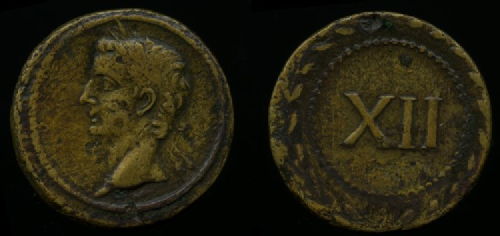 |
| Roman token showing Tiberius and XII within wreath. |
In reality, we know very little about these objects; their sexual scenery has created numerous forgeries, and very few archaeological contexts are known. They are often called spintriae, a label created in the modern era from a reading of Suetonius' Life of Tiberius. As part of the portrayal of Tiberius' activities on Capri, Suetonius records the presence of numerous female and male prostitutes, called spintrias (Suet. Tib. XLIII, see also Tacitus, Ann. VI.1; sphinthria or spintria referred to a male prostitute in Latin, from the Greek σφιγκτήρ, and connected to the Latin/modern word sphincter). It is this tale that inspired early collectors and scholars to label these objects spintriae, and when a hoard of tokens was found on Capri it cemented the name, though they were not called this in antiquity.
Indeed, the known find contexts of these objects suggest they had little to do with sex. Although hundreds of these specimens exist (precise numbers are difficult given the quantity of fakes in existence), only a handful of closed archaeological contexts are known. We cannot know whether the Thames example was lost in antiquity, or more recently. But one example was recently found in a tomb in Mutina; associated ceramics and other coins dates the tomb to AD 22-57, suggesting Buttrey's dating of the Julio-Claudian period is correct. Another was found during an archaeological campaign on the island of Majsan; this was pierced, suggesting it had been transformed into a piece of jewellery. Scattered other examples are reported to have been found in Caesarea Maritima, in the Garigliano in Italy, on Skegness beach (likely a modern loss) and in Germany (Stockstadt am Main, Saalburg, Nendorp-Wischenborg; these are sporadic finds). Although the information on the find places of these objects leaves much to be desired, none of these find spots are brothels, and in each example there is only one 'spintria' found. What their purpose was remains a mystery. Like many Roman tokens, much more study is required before we can fully understand these objects.

This month's coin was chosen by Clare Rowan. Clare is a research fellow at Warwick, who has recently become interested in the role tokens had in Roman society.
Coin images above reproduced courtesy of the Portable Antiquities Scheme and © The Trustees of the British Museum
Select Bibliography:
Benassi, F., N. Giordani and C. Poggi (2003). Una tessera numerale con scena erotica da un contesto funerario di Mutina. Numismatica e Antichità classiche 32: 249-273.
Buttrey, T. (1973). The spintriae as a historical source. Numismatic Chronicle 13: 52-63.
Martini, R. (1997). Tessere numerali bronzee romane nelle civiche raccolte numismatiche del comune di Milano Parte I. Annotazione Numismatische Supplemento IX: 1-28.
Mirnik, I. (1985). Nalazi novca s Majsana. VAMZ 18: 87-96.
July 01, 2015
Augustus and the gods
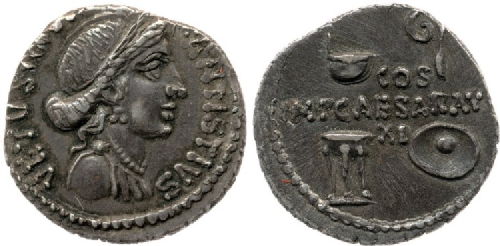
RIC Augustus 367, BMC Augustus 98 = LACTOR, Age of Augustus L1. Silver Denarius, 16 BC
Obverse: Bust of Venus right. C ANTISTVS VETVS IIIVIR = ‘Gaius Antistius Vetus, tresvir (monetalis)’
Reverse: symbols of priestly offices – the ladle (simpulum) top left, augur’s wand (lituus) top right, tripod bottom left and sacrificial bowl (patera) bottom right. COS IMP CAESAR AVGV XI = ‘Imperator Caesar Augustus, consul for the 11th time’.
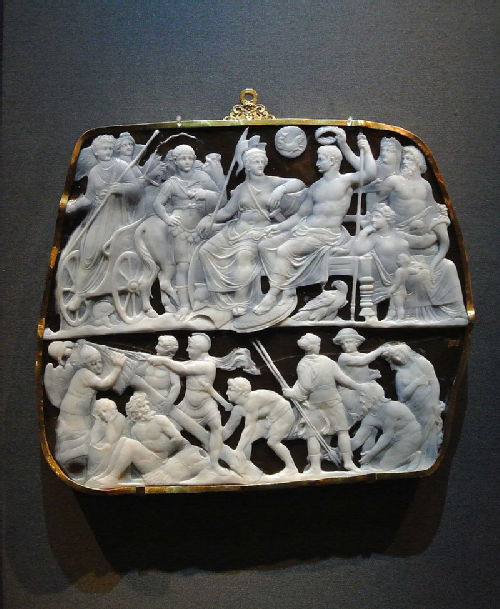 |
| Gemma Augustea |
Res Gestae divi Augusti 7.3 ‘I have been chief priest, augur, one of the Fifteen for conducting sacred rites, one of the Seven in charge of feasts, Arval brother, member of the fraternity of Titus, and fetial priest.’ Many passages of the Res Gestae find echoes in contemporary coinage. For Augustus, this list of his priesthoods was just as important as the magistracies which he had listed in the previous sentence. It was a common sentiment in Roman texts that the Romans’ divisive civil wars was a consequence of their neglect of the gods, who in turn then punished the Romans by provoking them to fight each other rather than the barbarian enemy who ought in the normal course of events to be the focus of any warfare. So the solemn opening of one of Horace’s so-called ‘Roman Odes’, 3.6, states ‘Ancestral crimes, though innocent, you’ll pay the gods for, Roman, till you restore their temples, their crumbling shrines, and images with black smoke besmirched’ (LACTOR G28). It is a commonplace to point out that, for Romans, their magistrates were their priests, and that religion and politics were regarded as inseparable. A Roman would not have understood the modern criticism made by some in contemporary Britain whenever a bishop or archbishop takes a stand on a point of politics.
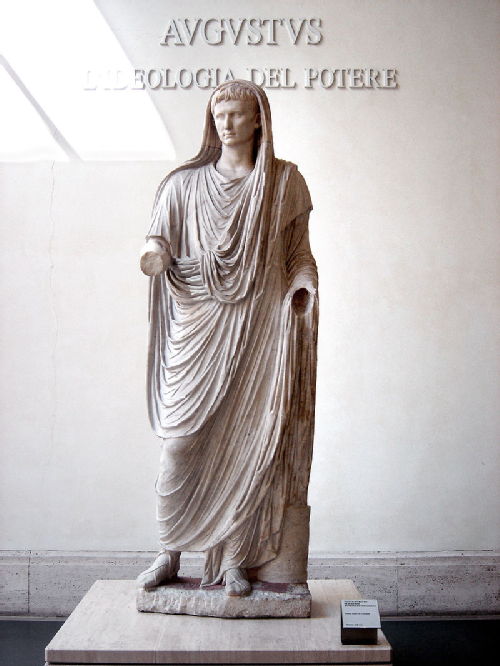 |
| via Labicana Augustus |
But in Augustus’ case, this coin is an excellent example of his typical blend of tradition and radical innovation. The presence of Venus on the obverse reminds us of the claims made by the Julian family to be descended from the goddess herself, via Aeneas, whilst the images on the reverse allude to the four major priesthoods in Rome. The ladle alludes to the pontifices, who had overall control of state cults; the lituus is both the wand used by the augurs in taking the auspices by observing the flight and song of birds and also a visual pun upon Augustus’ own name (compare too its appearance in Augustus’ hand on the gemma Augustea); the tripod alludes to the quindecimviri sacris faciundis, the college who were in charge of foreign cults in Rome, including consultation of the Sibylline oracle and the celebration of the Centennial Games; and finally, the patera recalls the college of the septemviri epulones in charge of sacred feasting at Rome. Traditionally, an individual held only one priesthood for life. Augustus had first been made a pontifex as early as 47 BC, in place of Domitius Ahenobarbus who had been killed at the battle of Pharsalos: he owed this promotion to the influence of his great-uncle Julius Caesar, who himself had exceptionally been a member of three priestly colleges. But it was Augustus who ended up as the first Roman ever to be a member of all four major colleges (and several minor ones too), accumulating them gradually over time, being elected augur in c.42 BC, quindecimvir in c.37 BC, and septemvir by 16 BC. One of the statues of Augustus most famous today – the via Labicana statue from Rome – depicts him in his role as priest, with veiled head. He makes the multi-titled Pooh-Bah of Gilbert and Sullivan’s Mikado – ‘First Lord of the Treasury, Lord Chief Justice, Commander-in-Chief, Lord High Admiral, Master of the Buckhounds, Groom of the Back Stairs, Archbishop of Titipu, and Lord Mayor, both acting and elect, all rolled into one’ – look almost unambitious! Both of these characters – though one fictional and the other real – may be compared for the way in which they both managed to bundle together the functions of the state into their own person. As Tacitus claimed, in the opening of the Annales, ‘he gradually increased his power, arrogating to himself the functions of the senate, the magistrates, and the law’.
By the end of Augustus’ lifetime, the link between Rome’s prosperity, the goodwill of the gods, and Augustus himself as the crucial intermediary with the gods in securing their support for Rome, was a message that was clear from a variety of visual and textual media.

This month's coin was chosen by Alison Cooley. Alison usually devotes her energies to Latin inscriptions, but is always delighted to have an excuse to look at coins too. Her commentary on the Res Gestae (CUP 2009) discusses other ways in which coins overlap with the messages promoted by that fascinating inscription. She is currently working on a project re-editing Latin inscriptions in the Ashmolean Museum: see our blog, Reading, Writing Romans.
Coin image © The Trustees of the British Museum.
Gemma Augustea CC-BY-SA 3.0 ("Gemma Augustea" by Dioscurides (?) - Self-photographed, October 2013 (James Steakley). Licensed under CC BY-SA 3.0 via Wikimedia Commons)
via Labicana Augustus from Wikimedia Commons. ("CaesarAugustusPontiusMaximus" by RyanFreisling at English Wikipedia - Transferred from en.wikipedia to Commons. Licensed under Public Domain via Wikimedia Commons)
March 04, 2015
Spocking Fives and a Mithraic token. Currency defacement ancient and modern.
 |
|
A Canadian $5 note that has been 'Spocked'
|
The death of Leonard Nimoy last week has sparked an upsurge in the Canadian practice of 'spocking' their $5 notes, using a pen or other implement to transform the portrait of their former Prime Minister, Wilfrid Laurier, into the famous Star Trek character. The particular style of the Prime Minister's portait, its large size, as well as the colour of the note (the same colour as Spock's uniform), serve to encourage this tradition (which has at least two active Facebook groups). While the alteration or defacement of currency is a crime in many societies, it is not strictly illegal in Canada, although the bank of Canada has stated that 'writing and markings on bank notes are inappropriate as they are a symbol of our country and a source of national pride'. Alterations to currencies often occur in the context of rebellion or dissatisfaction with the ruling power; defacement for fun or to honour someone is rarer.
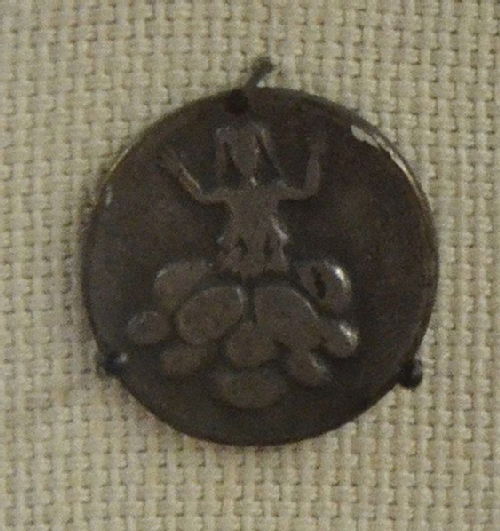 |
| Coin altered into a token |
Ancient parallels for the practice do exist, however. During excavations of a Roman building in St. Albans in Britain (ancient Verulamium), an object (shown left) was found under Building IV (the floor dated to the second century AD). It was a silver coin (denarius) that had been altered, similar to the Canadian note above. The coin had originally been a denarius of the emperor Augustus dating from 19-4 BC, showing the portrait of the emperor on one side, and part of an ancient Roman legend on the other: Tarpeia being crushed to death by shields. What the coin originally would have looked like is shown below.
The writing on the coin (naming the moneyer responsible) has been erased, as has the obverse. The portrait of Augustus was removed, and instead a Greek legend was inscribed on the coin (RIB 2408.2): ΜΙΘΡΑC ΩΡΟΜΑCDHC ΦΡΗΝ (Mithras Oromoasdes (Ormuzd) Phren). The edge of the coin is inscribed D M (D(eo) M(ithrae)): 'To the God Mithras'. The coin was thus converted into an object in honour of the god Mithras, a god which came to Rome from the East (Ormuzd was the chief Persian god, and Phren was likely a sun god). The reason this coin in particular was chosen for conversion was again because of its imagery: myth told that Mithras was born from a rock, and so the image of Tarpeia being crushed by shields could easily be reappropriated into an image showing the deity's birth. The date of the find (well after the coin was struck) suggests that the coin may have been quite old when it was converted, though it still will have been legal currency. The process of conversion, however, would have meant that this silver coin could no longer function as money in the Roman world. The object thus represents a sacrifice of wealth: Mattingly suggests it was perhaps a token to gain admission to Mithraic worship, or to show membership of a particular level of the Mithraic cult.
 |
|
Coin of Augustus showing Tarpeia (RIC 1 Augustus 299) |
Bibliography: H. Mattingly (1932). A Mithraic tessera from Verulam. Numismatic Chronicle 12: 54-7.
Images:
Canadian note: jordansawatzky via Compfight cc
Token: Wikimedia Commons.
Coin of Augustus: © Trustees of the British Museum.
October 01, 2014
The Power of Words?
 |
| Coin of Augustus with Latin on both sides (RIC 12 358) |
It is a truism that we are increasingly becoming a more visual age and one that plays down the impact of the written word. Everything has to have visual impact to engage and interest the passive spectator. Is PowerPoint the problem or the solution?
But, as often with the classical world, we have been there before. Coins are a good example of communicating a message through visual means and this Coin of the Month series has shown what a huge variety there are. Augustus, in particular, has been studied for his use of iconography in forming and disseminating the image that he wanted throughout the empire (see Zanker’s seminal book The Power of Images in the Age of Augustus).
This coin interested me for its lack of visual stimulus. It seeks to get its message through the written word. It is a denarius, about 18 mm in diameter. At this period, a legionary soldier received 10 asses a day, which amounted to 225 denarii a year.
One side of the coin (the obverse) has text within an oak wreath decorative border, reading as follows: I O M S P Q R S PR S IMP CAE QVOD PER EV R P IN AMP AT Q TRAN S E Expanding the standard abbreviations, adding letters in brackets, we see:
I(ovi) O(ptimo) M(aximo) S P Q R V(ota) S(uscepta) PR(o) S(alute) IMP(eratoris) CAE(saris) QVOD PER EV(m) R(es) P(ublica) IN AMP(liore) AT Q(ue) TRAN(quilliore) S(tatu) E(st)
To Jupiter Greatest and Best, the Senate and the Roman people (give) their vows made for the health of their leader Caesar (i.e. Augustus) because through him the state is in a greater and more peaceful condition.
On the other side is a cippus, a small, low pillar which usually had an inscription on it. On this representation of a cippus there is inscribed:
IMP CAES AVGV COMM CONS S C.
In full this reads:
IMP(erator) CAES(ar) AVGV(stus) COMM(uni) CONS(ensu), S(enatus) C(onsulto)
Caesar Augustus leader with common consent, and with the agreement of the Senate.
In addition, around the inside edge of the coin is written: L. MESCINIVS RVFVS IIIVIR This is the name of the magistrate (Lucius Mescinius Rufus) and his position as a moneyer (triumviri monetales) which helps to date the coin to 16 B.C.E.
How successful was this design? Well, we can’t tell from this one coin, but we do notice that there are other coins from this period with their emphasis on text rather than image, but after this we see very few. We can deduce from this that the innovation was a failure. Why might this be? Estimates of the level of literacy in the Roman world vary. As well as the graffiti of Pompeii, from the opposite ends of the Roman Empire we have writing from the tablets of Vindolanda and the papyri from Oxyrhynchus which suggests that there was a reasonable level of literacy throughout society, but interpretation of the evidence is disputed (Ancient Literacy by W. V. Harris provides a good starting point).
Could this coin have got its message across? Could enough people have read to make it effective? Were the abbreviations too much of a barrier? Was the size of characters too small (the coin is only around 18mm in diameter)? Did coins get worn too quickly? Do people ignore writing on coins (can you remember the words on a £1 coin?) Was it a brave attempt at a new, more sophisticated form of communication that did not work well enough? Perhaps it is true that a picture is worth a thousand words.

Clive Letchford is a Teaching Fellow in the department, teaching Latin and Greek to those who have not had the opportunity to learn these wonderful languages before arriving at Warwick.
(Image © The Trustees of the British Museum)
August 13, 2014
Disobedient Objects, Roman Coins and the Battle of Teutoberg Forest
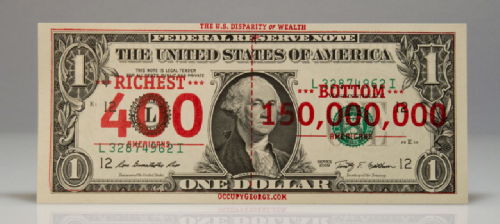 |
| US $1 bill, defaced by an ink stamp. From occupygeorge.com |
Included the Disobedient Objects exhibition currently at the V & A are a series of defaced monetary items, including the US dollar bill above. As material representations of a particular ruling authority that permeate our daily lives, currencies are often used to express dissatisfaction with governmental authorities, or even rebellion. A similar practice also occured in the Roman Empire, when the vast majority of circulating coinage carried the portrait of the emperor, an image that had strong power and charisma. In Roman culture it was vitally important to be remembered after one's death through one's actions and monuments; to destroy a monument or a portrait, then, was to attack the person's very being. (This Roman practice of destroying or defacing an image, whether material or literary, is called damnatio memoriae in modern scholarship).
We find numerous instances of coin mutilation and defacement in the Roman world: coins being slashed, stabbed, subject to graffiti, cut and pierced. If there is no archaeological context, it is difficult to know the motivations behind these actions. In some instances, a coin would be mutilated before being given as an offering to a deity (ensuring that the coin could never again be used for 'profane' commercial transactions, it would always belong to the god or goddess). We do not know the motivations behind the mutilation of the coin below, for example, recently found in Hertfordshire in Britain, and registered on the Portable Antiquities Scheme. But a well-known and clear example of politically motivated currency mutilation can be found at the archaeological site of Kalkriese.
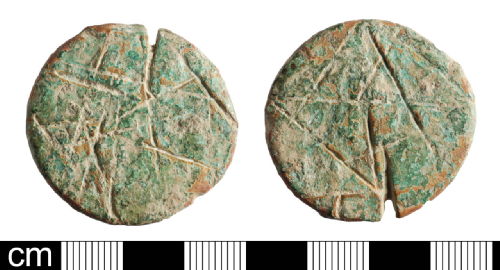 |
| Mutilated Roman Coin. (PAS BH-57-3B8). |
The site of Kalkriese was the site of a battle between Roman and German forces in the early first century AD. Though not universally accepted, many identify the site as the location of the Battle of Teutoberg Forest, in which the Roman general Varus was horribly defeated by the Germans in AD 9, losing several legions and cohorts. Amongst the finds on this ancient battlefield are numerous coins, with a large number of Augustan small bronze coins (called asses) from the mint at Lugdunum (Lyons). A significant proportion of these asses were defaced by stabbing, cuts or slashes. The original publication of these coins argued that these actions were performed by dissatisfied Roman troops (Berger). More recently, Kemmers and Myberg have suggested that the Germans may have been responsible: after defeating the Romans, the Germans then went on to deface one of the most potent symbols of Roman imperial power. Interpretation remains open, but the finds indicate that the coins must have been carried onto battlefield by the Romans. In this case it is perhaps unlikely that Roman troops were responsible for the mutilation - after the defacement the coins would no longer have been considered valid currency and there would be little reason for a Roman to be carrying them around, particularly into battle. The mutilation might thus have occured as part of the German post-battle victory celebrations.
For more on the defaced currrencies currently on display in London see this post. For the coins at Kalkriese see F. Berger, (1996). Kalkriese 1: Die römische Fundmünzen. Mainz; and F. Kemmers, F. and N. Myberg (2011). "Rethinking numismatics. The archaeology of coins." Archaeological Dialogues 18: 87-108.
August 01, 2014
The Emperor on a chain: Fashionable coins and questions of personal taste
 |
| Coin of Constantine used as a pendant |
This coin of Constantine dates from AD 330-331. It is typical of its type. The obverse displays an image of Constantine whilst the reverse praises the might of the Roman army; two soldiers holding spears flank military standards with the legend ‘GLORIA EXERCITVS’. The modern transformation of this particular coin into a piece of jewellery is not without its ancient precedent, and this has prompted me to investigate the afterlife of coinage in the Roman world.
It is widely accepted that coins are not simply important for their monetary value. To historians studying numismatics their imagery and legends provide evidence for things as diverse as architectural styles to hairstyles. Similarly, at the time of minting, coins held a value which extended further than what they could buy. The way that coins were used outside of the context of financial transactions can teach us valuable lessons about Roman society.
In Petronius’ Satyricon, the character Trimalchio is described as playing a board game with gold and silver denarii instead of the standard black and white counters. Trimalchio is more of a caricature than a character, so we should take scenes like this with a pinch of salt, but the author is here making a point about how the attitude of an individual towards coinage projects a social statement about their personal wealth. Trimalchio’s self-display tells his guests that he can, quite frankly, afford to play with his money. This can be extended to help us to understand why incorporating coinage into jewellery was a way of displaying your wealth and social status.
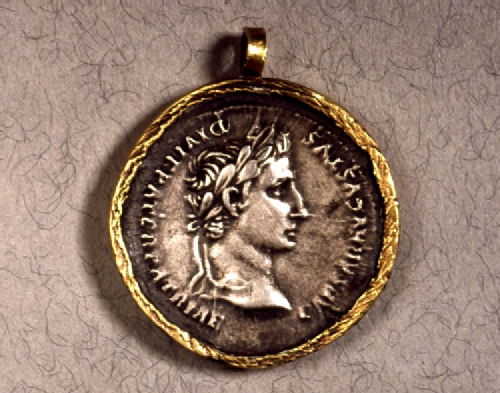 |
|
Coin of Augustus used as a pendant © The Trustees of the British Museum |
But self-display was not the sole reason why an individual would choose to transform coins into jewellery. Nor can it simply be explained as a fashion, since fashions change and our evidence for coin pendants spans hundreds of years. A study of the iconography of the coins chosen for this purpose suggests that not just any coin would do. Generally our examples are drilled to allow a chain to pass through, or else a loop attached, and the location of this tells us which way the coin was intended to hang. In most cases the coin was orientated to display the obverse, most tellingly, the image of the emperor. For example, the coin pictured here is orientated to display the diademed profile of Augustus. This coin was minted in 2 BC and its use here celebrates the reign of Augustus. Thus one could argue that coin pendants projected a political as well as social message. The modern day transformation of the ‘Gloria Exercitvs’ coin follows this ancient precedent, but this time the choice was motivated by aesthetic value rather than a desire to make a political statement of allegiance to the emperor.
It is debatable whether the Roman jeweller was motivated by the aesthetic, political or social potential of coinage when they set about incorporating coins into jewellery. Clearly, these artefacts pose questions about the nature of Roman society and the nature of its value system; and since coin pendants remain popular today we could trick ourselves into believing that we are not so different from the Romans after all.
 This month's coin was chosen by Eve Bayram. Eve graduated from Warwick in 2014 with a degree in Classical Civilisation. While at Warwick Eve focused on the study of Latin literature, and her disseration was entitled 'Self-presentation in the Latin epistolary genre: Cicero, Seneca, Petrarch.' She is currently interning in the dictionaries department at Oxford University Press.
This month's coin was chosen by Eve Bayram. Eve graduated from Warwick in 2014 with a degree in Classical Civilisation. While at Warwick Eve focused on the study of Latin literature, and her disseration was entitled 'Self-presentation in the Latin epistolary genre: Cicero, Seneca, Petrarch.' She is currently interning in the dictionaries department at Oxford University Press.
July 15, 2014
Augustus and Communicating the Succession
 |
|
Augustus and Agrippa seated on a platform |
As the first emperor or princeps of Rome, Augustus' power was based solely on the positions he held and his proven achievements. There was no established mechanism by which a successor could come to power; the idea of a hereditary monarchy did not exist. Therefore the question of who or what would follow Augustus was a problem indeed, particularly since Augustus himself had no living male heir when he became seriously ill in 23 BC. After the death of her first husband, Augustus married his daughter Julia to his chief general and advisor, Agrippa. The sons of this union, Gaius and Lucius Caesar, were then adopted by Augustus in 17 BC. In order to designate them as successors these brothers were granted a series of honours and positions in spite of their young ages.
 |
|
Aureus with Augustus and Agrippa |
The entire process of appointing a successor a delicate one, and one of our first indications of an official statement of dynastic ideology can be found in a series of coins issued at Rome in 13 BC. This was the year the tribunician power of Augustus and Agrippa was renewed, and Agrippa is shown on the coinage as Augustus' colleague (just as he is later named as a colleague in the Res Gestae Divi Augusti 8.2). Coins show Augustus and Agrippa side-by-side: on the coin above, the portrait of Augustus graces the obverse, while Augustus and Agrippa are seated in togas on the reverse (RIC 12 407). Other issues of this year display the head of Augustus on one side, and the head of Agrippa on the other. On the silver denarius issue of this type, both Augustus and Agrippa are bare-headed, while on the gold aureus issue shown here Augustus wears an oak-crown (an honour granted him by the Senate) and Agrippa a combined mural and rostral crown, which combined the walls of a city and the prow of a ship (RIC 12 409). Silver denarii were also struck showing Julia and her two sons: the obverse carries the portrait of Augustus accompanied by a lituus, and the reverse displays the bust of Julia with a wreath above it, flanked by the busts of her sons (RIC 12 404-5).
 |
|
Denarius showing Julia between Gaius and Lucius |
Alas, the following year Agrippa died, and Gaius and Lucius would both also die before Augustus. It was this series of unfortunate deaths that meant that Tiberius would marry Julia and as Augustus' adopted son, become the successor of his power and offices.
(Images are © The Trustees of the British Museum).
Good images of all of Augustus' coinage can also now be found on the Online Coins of the Roman Empire site.
June 01, 2014
Coin of the Month: Augustus, and How to Make Road Repairs Exciting
 |
| Denarius of Augustus, © The Trustees of the British Museum |
This month's coin of the month is a silver denarius struck in Rome in 16 BC commemorating Augustus' improvement of the roads in Italy. These road repairs were evidently an important part of Augustus' building programme. In fact, he takes pains to mention them in his Res Gestae (20.5): "In my seventh consulship I constructed the Flaminian Way from Rome to Arminum and all the bridges on it except for two that were not in need of repair" (trans. Cooley). The completion of these works were marked by this coin and by others struck in mints in Spain.
The iconography of this coin is highly unusual, reflective of the experimental atmosphere that prevailed under Augustus as an imperial language of numismatic imagery was formulated. The odd nature of the imagery on this piece, however, may also have been due to the difficulties in visualising this particular act of imperial munificence. After all, how do you design a coin which communicates road repairs?? And in an eye catching and exciting way?? The designers of this coin chose to focus on objects which alluded to Augustus' activities without actually having to show a road. The obverse of the coin (left) shows a statue of Augustus on a horse before the walls of the city, likely an allusion to the beginning of the Flaminian Way. The reverse shows a column erected by the Senate for Augustus in Rome to thank him for his repairs. The column reads:S P Q R IMP CAE QVOD V(iae) M(unitae) S(unt) EX EA P(ecunia) Q(u)IS AD A(erarium) DE(dit) (The senate and people of Rome to Imperator Caesar because the roads have been paved out of the money which he gave to the treasury).
The mints in Spain that struck similar types (see examples here, and here) echo the same phrase (QVOD VIAE MUNITAE SVNT, because the roads have been paved), suggesting that these coins are co-ordinated in some way, or responding to the same edict. The Spanish coins also highlight statues of Augustus that graced the roads and bridges, rather than representing the roads themselves. Statues of Augustus in connection with the roads are mentioned by Dio (53.22.1), but what is most interesting about these issues is that the statues are shown all out of proportion to the bridges and the city wall (they are shown as larger than life). As Zanker points out, this is because coins reflect how the Romans viewed monuments, rather than provide us with a 'photo' or realistic representation. In the early imperial period, statues are often shown as larger than the buildings or monuments themselves on coins, a reflection of the fact that Romans were most interested in the political message of a particular building programme. Later on in the Empire, the statues become smaller and the buildings themselves dominate coin types, reflecting a change in the practice of Roman viewing.
 This month's coin was chosen by Clare Rowan, a Research Fellow in Numismatics. Amongst other projects she is currently working on a Cambridge University Press/American Numismatic Society Handbook to Coinage of the Ancient World, covering the period from 49 BC until AD 14.
This month's coin was chosen by Clare Rowan, a Research Fellow in Numismatics. Amongst other projects she is currently working on a Cambridge University Press/American Numismatic Society Handbook to Coinage of the Ancient World, covering the period from 49 BC until AD 14.
May 01, 2014
Coin of the Month: A Denarius of Augustus, Presenting a Dynasty
 |
| Denarius of Augustus |
This denarius of Augustus dates from 2-4 BC. The obverse features a laureate head of Augustus with the legend ‘CAESAR AVGVSTVS DIVI F PATER PATER PATRIAE’. The reverse depicts his two grandsons Gaius and Lucius stood facing each other, hands resting on a shield and spear, with a simpulum and lituus above. The legend around the edge reads ‘AVGVSTI F COS DESIG PRINC IVVENT’ and ‘C L CAESARES’ is written horizontally underneath the figures.
The coin is a useful example of the control that Augustus exercised over his personal image. The bust appears as that of a young man, however the emperor would have been in his 60s at this point. It is also illustrative of the problem of succession that faced an ageing Augustus. Having no sons of his own, the emperor had adopted his two grandsons and this coin is a clear message that they are the heirs to his title and powers. The beginning of their public careers is alluded to by the presentation of the title of “Leaders of the Youth”, as well as the appearance of both military and priestly images around them. Gaius’ and Lucius’ positions within the family are also emphasised by the fact that the two are explicitly called the sons of Augustus. Also, the prominent way in which ‘Caesares’ is placed upon the coin has clearly dynastic overtones, especially given that it was the name that Augustus himself took following his own “adoption” by Julius Caesar, which launched his political career. This theme is further continued on the obverse, where Augustus presents the title ‘Divi Filius’ (“Son of a God”) alongside that of ‘Pater Patriae’ (“Father of the Country”). By presenting himself as both son and father, Augustus is drawing the parallel to his own adoption as well as that of his grandsons and it is made clear that an imperial dynasty, with the successive handing down of powers, has been founded.
This particular denarius is contained within the South-Warwickshire Hoard of Roman denarii, which was discovered in 2008 by a local metal-detectorist. The hoard is comprised of 1153 silver denarii, with dates ranging from 190 BC to AD 64. It is one of the largest coin hoards from the Roman world and is made even more special by the fact that the pot in which the coins were buried has also survived. The South-Warwickshire Hoard was acquired by Warwickshire Museum, catalogued by Stanley Ireland and it is currently on display at the Market Hall Museum in Warwick.
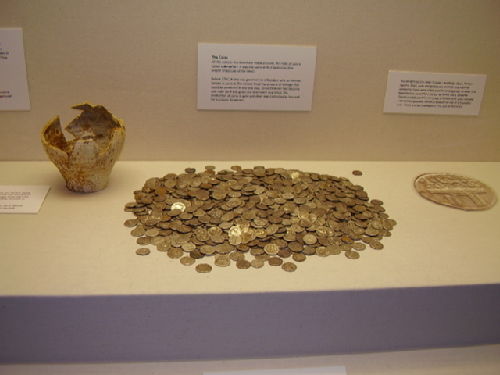 |
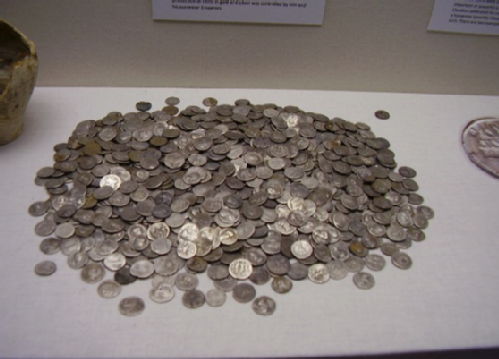 |
The South Warwickshire Hoard in the Warwickshire Museum
This month's coin was chosen by Abigael Flack, a museum assistant at the Warwickshire museum. Abigael is interested in the presentation and reception of the Roman imperial regime, particularly in literature. Her MA thesis examined this theme in the biographies of Suetonius.
(Images courtesy of Sara Wear and Heritage & Culture Warwickshire.)
March 18, 2014
The Many Faces of Augustus
 |
| Spanish coin showing Augustus and shield |
During the period in which Augustus came to hold sole power in the Roman Empire, the minting of Roman coinage was decentralised. Instead of coinage only being struck at Rome, different generals and Roman officers struck Roman denarii at a series of different mints throughout the Empire. Indeed, coinage was probably only struck in Rome again from c. 19 BC. This means that in the period after Actium, the coinage of Augustus was struck in a variety of different mints, which meant that the image and associations of Augustus and his rule had regional differences, at least initially.
The decentralised nature of minting in this period also meant that there was the possibility for official images of Augustus to become 'entangled' with local iconographies - that is, for Roman officials and mints to take inspiration from local currency designs, either as a way of communicating Augustus' power to local populations, or as a strategy to make the currency more acceptable. Several interesting coin designs have resulted from this process, one of which is a series of coins struck in an uncertain mint in Spain (RPC 1 1-4). This coinage lacks the name of a city, and so is probably an imperial series of Augustus, although it is not listed as such in the catalogue of Roman Imperial Coinage. On this series Augustus is presented as the son of the divine Julius Caesar (IMP AVG DIVI F), and his portrait is accompanied by a palm branch and winged caduceus. These two attributes were commonly seen on the local coins struck in Spain (Iberia); the palm branch is often shown being held by a horse rider (see one example here), and the winged caduceus appears on the coinage of several cities (e.g. as a reverse type, or being held by the Tyche of a Spanish city on a coin series struck by Sextus Pompey).
 |
| Similar coin, but with dagger and Iberian sword |
The image of Augustus presented here is thus one with a particular 'Iberian' flair. This is further suggested by the reverses of this coin series, which show an Iberian shield, sometimes accompanied by a dagger and Iberian sword. These coins are mostly found in NW Spain, meaning that the image and associations of Augustus in this region would likely have been different to that found in the East of the Empire, for example, or even in Gaul. Augustus presented many faces to different audiences, as he and his subordinates sought to communicate the new power structure to the broader Roman Empire.
(Coin images reproduced courtesy of Classical Numismatic Group Inc., www.cngcoins.com)
 Clare Rowan
Clare Rowan

 Please wait - comments are loading
Please wait - comments are loading

 Loading…
Loading…

